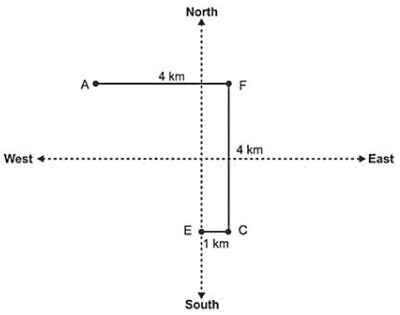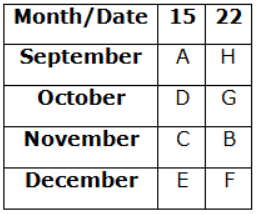IBPS RRB PO (Scale 1) Prelims Mock Test - 1 - Bank Exams MCQ
30 Questions MCQ Test - IBPS RRB PO (Scale 1) Prelims Mock Test - 1
Direction: In the question below are given three statements followed by three conclusions numbered I, II and III. You have to take the given statements to be true even if they seem to be at variance with commonly known facts. Read all the conclusions and then decide which of the given conclusions logically follows from the given statements disregarding commonly known facts.
Statements:
Only bed is table.
Some bed are glass.
No glass is blanket.
Conclusions:
I. No bed is blanket.
II. Some table can be glass.
III. Few bed are blanket.
Direction: In the question below are given three statements followed by three conclusions numbered I, II and III. You have to take the given statements to be true even if they seem to be at variance with commonly known facts. Read all the conclusions and then decide which of the given conclusions logically follows from the given statements disregarding commonly known facts.
Statements:
Only mobile are laptop.
Some mobile are charger.
Some charger are adapter.
Conclusions:
I. Some laptop are not charger.
II. No adapter are laptop.
III. All laptop are charger is a possibility.
Direction: In the question below are given three statements followed by three conclusions numbered I, II and III. You have to take the given statements to be true even if they seem to be at variance with commonly known facts. Read all the conclusions and then decide which of the given conclusions logically follows from the given statements disregarding commonly known facts.
Statements:
Only a few heros are actors.
Few actors are hollywood.
Only a few hollywood are bollywood.
Conclusions:
I. All Hollywood are bollywood.
II. Some Hollywood are not bollywood.
III. Few heros are actors.
Study the following information carefully and answer the questions given below.
Ten boxes - C, D, E, F, G, H, I, J, K and L are kept one above the other in a single stack, but not necessarily in the same order.
Only four boxes are kept between box L and box H, which is kept below box L. At least one box is kept above box D, which is kept immediately above box L. The number of boxes kept above box D is the same as the number of boxes kept below box K. Only two boxes are kept between box K and box I. Box C is kept immediately above box F, which is not kept adjacent to box D. Box G is kept above box E but below box J. More than two boxes are kept between box E and box G.
Q. What is the position of box C?
Study the following information carefully and answer the questions given below.
Ten boxes - C, D, E, F, G, H, I, J, K and L are kept one above the other in a single stack, but not necessarily in the same order.
Only four boxes are kept between box L and box H, which is kept below box L. At least one box is kept above box D, which is kept immediately above box L. The number of boxes kept above box D is the same as the number of boxes kept below box K. Only two boxes are kept between box K and box I. Box C is kept immediately above box F, which is not kept adjacent to box D. Box G is kept above box E but below box J. More than two boxes are kept between box E and box G.
Q. Which of the following box is kept immediately below box H?
Study the following information carefully and answer the questions given below.
Ten boxes - C, D, E, F, G, H, I, J, K and L are kept one above the other in a single stack, but not necessarily in the same order.
Only four boxes are kept between box L and box H, which is kept below box L. At least one box is kept above box D, which is kept immediately above box L. The number of boxes kept above box D is the same as the number of boxes kept below box K. Only two boxes are kept between box K and box I. Box C is kept immediately above box F, which is not kept adjacent to box D. Box G is kept above box E but below box J. More than two boxes are kept between box E and box G.
Q. How many boxes are kept between box G and box I?
Study the following information carefully and answer the questions given below.
Ten boxes - C, D, E, F, G, H, I, J, K and L are kept one above the other in a single stack, but not necessarily in the same order.
Only four boxes are kept between box L and box H, which is kept below box L. At least one box is kept above box D, which is kept immediately above box L. The number of boxes kept above box D is the same as the number of boxes kept below box K. Only two boxes are kept between box K and box I. Box C is kept immediately above box F, which is not kept adjacent to box D. Box G is kept above box E but below box J. More than two boxes are kept between box E and box G.
Q. Which of the following statement is true with respect to box J?
Study the following information carefully and answer the questions given below.
Ten boxes - C, D, E, F, G, H, I, J, K and L are kept one above the other in a single stack, but not necessarily in the same order.
Only four boxes are kept between box L and box H, which is kept below box L. At least one box is kept above box D, which is kept immediately above box L. The number of boxes kept above box D is the same as the number of boxes kept below box K. Only two boxes are kept between box K and box I. Box C is kept immediately above box F, which is not kept adjacent to box D. Box G is kept above box E but below box J. More than two boxes are kept between box E and box G.
Q. If box J is related to box D and box I is related to box F in a certain way, then which of the following box is related to box K?
Direction: Read the following information carefully and answer the given question:
Nine people A, B, C, D, E, F, G, H, and I are seated in a straight line facing south direction but not necessarily in the same order.
D and C are sitting at the extreme ends. A sits second to the right of C. E sits third to the right of G. two people are sitting between F and C but none of them are E and G. C and I are not neighbors. D sits third to the right of H.
Q. Who among the following sits between G and A?
Direction: Read the following information carefully and answer the given question:
Nine people A, B, C, D, E, F, G, H, and I are seated in a straight line facing south direction but not necessarily in the same order.
D and C are sitting at the extreme ends. A sits second to the right of C. E sits third to the right of G. two people are sitting between F and C but none of them are E and G. C and I are not neighbors. D sits third to the right of H.
Q. What is the position of I with respect to F?
Direction: Read the following information carefully and answer the given question:
Nine people A, B, C, D, E, F, G, H, and I are seated in a straight line facing south direction but not necessarily in the same order.
D and C are sitting at the extreme ends. A sits second to the right of C. E sits third to the right of G. two people are sitting between F and C but none of them are E and G. C and I are not neighbors. D sits third to the right of H.
Q. Which of the following is immediate neighbor of each other?
Direction: Read the following information carefully and answer the given question:
Nine people A, B, C, D, E, F, G, H, and I are seated in a straight line facing south direction but not necessarily in the same order.
D and C are sitting at the extreme ends. A sits second to the right of C. E sits third to the right of G. two people are sitting between F and C but none of them are E and G. C and I are not neighbors. D sits third to the right of H.
Q. How many persons are seated between H and B?
Direction: Read the following information carefully and answer the given question:
Nine people A, B, C, D, E, F, G, H, and I are seated in a straight line facing south direction but not necessarily in the same order.
D and C are sitting at the extreme ends. A sits second to the right of C. E sits third to the right of G. two people are sitting between F and C but none of them are E and G. C and I are not neighbors. D sits third to the right of H.
Q. Which of the following statements are true with respect to the given arrangement?
In the given questions, the relationship between different elements is shown in the statements followed by some conclusions. Find the conclusion which is definitely true.
Given Answers:
a) Only conclusion I is true
b) Only conclusion II is true
c) Either conclusion I or II is true
d) Neither conclusion I nor II is true
e) Both conclusions I and II are true
Statement:
X = H ≥ I ≥ U = D ≤ W ≤ C
Conclusions:
I). U < H
II). D = H
In the given questions, the relationship between different elements is shown in the statements followed by some conclusions. Find the conclusion which is definitely true.
Given Answers:
a) Only conclusion I is true
b) Only conclusion II is true
c) Either conclusion I or II is true
d) Neither conclusion I nor II is true
e) Both conclusions I and II are true
Statements:
A > B > G > L; B < E; D > A
Conclusions:
I). D < E
II). E > L
In the given questions, the relationship between different elements is shown in the statements followed by some conclusions. Find the conclusion which is definitely true.
Given Answers:
a) Only conclusion I is true
b) Only conclusion II is true
c) Either conclusion I or II is true
d) Neither conclusion I nor II is true
e) Both conclusions I and II are true
Statements:
B ≤ D ≤ F ≤ K; M ≤ B; K > R
Conclusions:
I). F > M
II). D > R
In the given questions, the relationship between different elements is shown in the statements followed by some conclusions. Find the conclusion which is definitely true.
Given Answers:
a) Only conclusion I is true
b) Only conclusion II is true
c) Either conclusion I or II is true
d) Neither conclusion I nor II is true
e) Both conclusions I and II are true
Statements:
R ≤ S; P ≥ Q; S ≥ T; Q > R
Conclusions:
I). P ≥ S
II). Q > T
Direction: Read the following information carefully and answer the questions that follow:
A & B means A is 4 km to west of B,
A + B means A is 4 km to north of B,
A # B means A is 4 km to south of B,
A @ B means A is 4 km to east of B,
A % B means A is 1 km to east of B.
Q. If it is given that: U # T% Q; P & Q; U @ R % S. What is the distance between P and S?
Direction: Read the following information carefully and answer the questions that follow:
A & B means A is 4 km to west of B,
A + B means A is 4 km to north of B,
A # B means A is 4 km to south of B,
A @ B means A is 4 km to east of B,
A % B means A is 1 km to east of B.
Q. If it is given that: A & F; C # F; C % E. What is the minimum distance between E and A?
Study the following information carefully and answer the questions given below.
Seven persons - A, B, C, D, E, F and G are sitting in a linear row facing towards north, but not necessarily in the same order. Each person likes different colours - Yellow, Red, White, Green, Blue, Orange and Pink.
Only four persons sit to the left of E. Only one person sits between E and the one who likes Yellow. Only three persons sit between the persons who like Yellow and White. A sits immediate left of the one who likes White. As many persons sit to the right of A as to the left of the one who likes Orange. F sits four places away from G, who sits immediate left of the one who likes Blue. Only two persons sit between the one who likes Blue and B. The one who likes Pink sits second to the right of C. B doesn’t like Green colour.
Q. Who among the following person likes Green colour?
Study the following information carefully and answer the questions given below.
Seven persons - A, B, C, D, E, F and G are sitting in a linear row facing towards north, but not necessarily in the same order. Each person likes different colours - Yellow, Red, White, Green, Blue, Orange and Pink.
Only four persons sit to the left of E. Only one person sits between E and the one who likes Yellow. Only three persons sit between the persons who like Yellow and White. A sits immediate left of the one who likes White. As many persons sit to the right of A as to the left of the one who likes Orange. F sits four places away from G, who sits immediate left of the one who likes Blue. Only two persons sit between the one who likes Blue and B. The one who likes Pink sits second to the right of C. B doesn’t like Green colour.
Q. Who among the following person sits immediate right of the one who likes Red colour?
Study the following information carefully and answer the questions given below.
Seven persons - A, B, C, D, E, F and G are sitting in a linear row facing towards north, but not necessarily in the same order. Each person likes different colours - Yellow, Red, White, Green, Blue, Orange and Pink.
Only four persons sit to the left of E. Only one person sits between E and the one who likes Yellow. Only three persons sit between the persons who like Yellow and White. A sits immediate left of the one who likes White. As many persons sit to the right of A as to the left of the one who likes Orange. F sits four places away from G, who sits immediate left of the one who likes Blue. Only two persons sit between the one who likes Blue and B. The one who likes Pink sits second to the right of C. B doesn’t like Green colour.
Q. As many persons sit to the left of B as to the right of _____.
Study the following information carefully and answer the questions given below.
Seven persons - A, B, C, D, E, F and G are sitting in a linear row facing towards north, but not necessarily in the same order. Each person likes different colours - Yellow, Red, White, Green, Blue, Orange and Pink.
Only four persons sit to the left of E. Only one person sits between E and the one who likes Yellow. Only three persons sit between the persons who like Yellow and White. A sits immediate left of the one who likes White. As many persons sit to the right of A as to the left of the one who likes Orange. F sits four places away from G, who sits immediate left of the one who likes Blue. Only two persons sit between the one who likes Blue and B. The one who likes Pink sits second to the right of C. B doesn’t like Green colour.
Q. How many persons sit between the persons who like Pink and Orange colour?
Study the following information carefully and answer the questions given below.
Seven persons - A, B, C, D, E, F and G are sitting in a linear row facing towards north, but not necessarily in the same order. Each person likes different colours - Yellow, Red, White, Green, Blue, Orange and Pink.
Only four persons sit to the left of E. Only one person sits between E and the one who likes Yellow. Only three persons sit between the persons who like Yellow and White. A sits immediate left of the one who likes White. As many persons sit to the right of A as to the left of the one who likes Orange. F sits four places away from G, who sits immediate left of the one who likes Blue. Only two persons sit between the one who likes Blue and B. The one who likes Pink sits second to the right of C. B doesn’t like Green colour.
Q. Which of the following statement(s) is/are true with respect to the final arrangement?
I. Only two persons sit to the left of F.
II. The one who likes Yellow colour sits second to the right of B.
III. B likes Blue colour.
Direction: Read the following information carefully and answer the question that follow.
Six people Gh, Gp, Gk, Gm, Gj and Gt are of six different ages. The ages of all of them are prime number but less than 14. The number of people older than Gm is the same as the number of persons younger than Gh. Gk’s age is less than than 9. Gm is neither the oldest nor the youngest among all of them but older than Gj. Gj is five years older than Gp’s age.
Q. Who among them is youngest?
Direction: Read the following information carefully and answer the question that follow.
Six people Gh, Gp, Gk, Gm, Gj and Gt are of six different ages. The ages of all of them are prime number but less than 14. The number of people older than Gm is the same as the number of persons younger than Gh. Gk’s age is less than than 9. Gm is neither the oldest nor the youngest among all of them but older than Gj. Gj is five years older than Gp’s age.
Q. Who among them is oldest?
Direction: Read the following information carefully and answer the question that follow.
Six people Gh, Gp, Gk, Gm, Gj and Gt are of six different ages. The ages of all of them are prime number but less than 14. The number of people older than Gm is the same as the number of persons younger than Gh. Gk’s age is less than than 9. Gm is neither the oldest nor the youngest among all of them but older than Gj. Gj is five years older than Gp’s age.
Q. How many persons are older than Gk?
Study the following information carefully and answer the questions given below.
Eight persons - A, B, C, D, E, F, G and H attend the seminar on two different dates either 15th or 22nd of four different month viz. September, October, November and December of the same year, but not necessarily in the same order.
A attends the seminar in an odd numbered date of the month having an even number of days. Only two persons attend the seminar between A and G. As many persons attend the seminar before G as after C. Only three persons attend the seminar between H and B, who attend the seminar in the same month as C. F attends the seminar two persons after B. More than two persons attend the seminar between F and D.
Q. Who among the following person attends the seminar on October 15th?
Study the following information carefully and answer the questions given below.
Eight persons - A, B, C, D, E, F, G and H attend the seminar on two different dates either 15th or 22nd of four different month viz. September, October, November and December of the same year, but not necessarily in the same order.
A attends the seminar in an odd numbered date of the month having an even number of days. Only two persons attend the seminar between A and G. As many persons attend the seminar before G as after C. Only three persons attend the seminar between H and B, who attend the seminar in the same month as C. F attends the seminar two persons after B. More than two persons attend the seminar between F and D.
Q. Which of the following statement(s) is/are true with respect to the final arrangement?
I. A attends the seminar in November.
II. Only one person attends the seminar between H and C.
III. Only two persons attend the seminar after B.
Study the following information carefully and answer the questions given below.
Eight persons - A, B, C, D, E, F, G and H attend the seminar on two different dates either 15th or 22nd of four different month viz. September, October, November and December of the same year, but not necessarily in the same order.
A attends the seminar in an odd numbered date of the month having an even number of days. Only two persons attend the seminar between A and G. As many persons attend the seminar before G as after C. Only three persons attend the seminar between H and B, who attend the seminar in the same month as C. F attends the seminar two persons after B. More than two persons attend the seminar between F and D.
Q. As many persons attend the seminar before E as after ____.














































